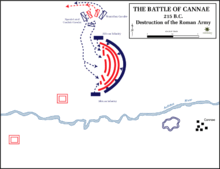- Numidian cavalry
-
 The battle of Cannae, where the Numidian cavalry helped to defeat the Roman cavalry, allowing the Carthaginians (blue) to encircle and defeat the Roman army (red)
The battle of Cannae, where the Numidian cavalry helped to defeat the Roman cavalry, allowing the Carthaginians (blue) to encircle and defeat the Roman army (red)
Numidian cavalry was a type of light cavalry developed by the Numidians, most notably used by Hannibal during the Second Punic War. They were described by the Roman historian Livy as "by far the best horsemen in Africa." [1]
The Numidian cavalry's horses, ancestors of the Arabian horse, were smaller than those of the contemporary Roman cavalry and were well adapted for faster movement.[2] To conserve weight, the cavalrymen did not use a saddle or bridle, did not wear armor, and carried smaller shields. Their weaponry consisted mainly of spears and javelins, in addition to a short sword.[3]
Due to their expert horsemanship and agility, they were most suitable for charging and then dispersing, an effective tactic for harassing the enemy and breaking up their formations. Hannibal's invasion of Rome during the Second Punic War is best known for his use of slow-moving war elephants, but he also employed Numidian cavalry where faster movement was needed, such as luring the Romans into a trap at the Battle of Trebia[4] and for fighting on his right flank.
Numidian cavalry were widely known and not only fought in the Carthaginian army, but in other armies of the time as well – the Romans even employed Numidian cavalry against Hannibal's own in the battle of Zama,[5] where the "Numidian Cavalry turned the scales".[6]
For centuries thereafter, the Roman army employed Numidian light cavalry in separate units (equites Numidarum or Maurorum).
References
- ^ Livy, Ab Urbe Condita 29.35.8.
- ^ Epona
- ^ RedRampant.com
- ^ Invasion of Italy
- ^ Sidnell, Philip. Warhorse: Cavalry in the Ancient World, p.194.
- ^ Fuller, J.F.C., Julius Caesar: Man, Soldier, and Tyrant. p. 28 ISBN 0306804220

This article about the military history of Ancient Rome is a stub. You can help Wikipedia by expanding it.
